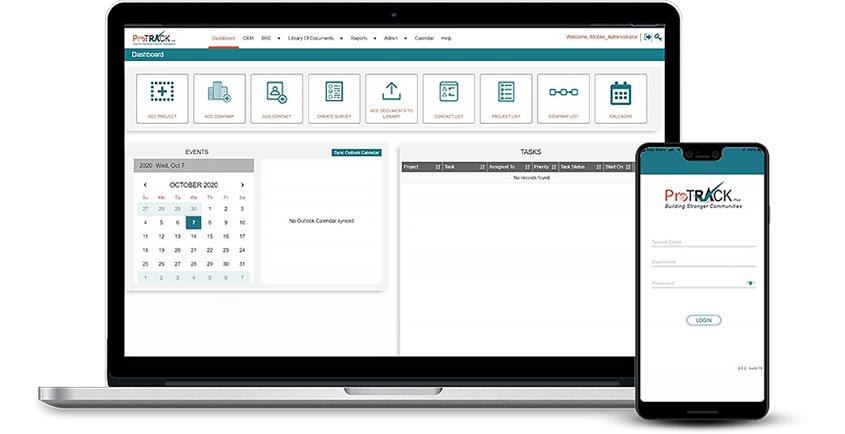
SVAM International Inc.’s ProTRACKPlus is a dedicated SaaS-based CRM tool developed exclusively for Economic Development Organizations (EDOs). It is customized to provide ensure tracking of active projects, managing contacts, managing companies, and boosting reporting activities to increase leadership’s ownership. The tool is specifically built to provide all basic functionalities of a CRM, plus six more tools.
The tool exceeds the expectations of users by providing features that offer an extra edge and control to EDOs. The customized dashboards maximize transparency, accountability, and communications within the business, and a completely automated reporting and tracking system helps in managing your relationships with your existing and prospecting businesses while saving you precious time and money. Let’s take a deeper look into the compelling features of this software!
The Unique Features of ProTRACKPlus
- Real-Time Reporting
One of the most important features of a great CRM tool is reporting. ProTRACKPlus comes with seven built-in reports plus a totally customizable report generator that can publish all your real-time metrics. These dynamic reports keep your leadership well-informed about projects, contacts, and companies. These reports come in handy when there are financial decisions to be made and they need to be backed up by strong data.
- Managing your Business Retention and Expansion (BRE)
As the businesses in your locale come back online, they will need all the help you can give them. ProTRACKPlus has a built-in survey generator with multiple ways of distributing questionnaires and forms. When these are completed and submitted by the respondent, the data automatically populates into the respective company’s profile. All data is then automatically aggregated, totaled, and presented using colorful charts and graphs. You don’t have to do anything but author the questions and/or forms and ProTRACKPlus handles everything else.
- Security
One of the most interesting features of ProTRACKPlus is the built-in proprietary “Safe Room” where you can store all important documents like financial statements, offer letters and deal sheets. The data stored here is not meant for publication and if someone sends an email to the source of the confidential data from the Safe Room, the moderator only has a limited amount of time or window to submit it before the system closes again.
- Document Library
The document library is for sharing files and documents that can be viewed throughout the organization. The categories and subcategories found in the program’s library help you in managing a large volume of documents. In fact, you can edit the categories and subcategories to match your EDO’s needs.
- Flexible
The admin panel on ProTRACKPlus allows you to edit 90% of all fields, tabs, and drop-down menus in the tool to what you will need in your daily operations. This also includes how your reports will look, so you and your leadership will have accurate and up-to-date information whenever you need it. All changes are automatically captured and updated throughout the tool for real-time use. Imagine all the time you will save on customizing weekly, monthly, and annual reports.
ProTRACKPlus is the result of the joint expertise of professionals and visionaries from SVAM International Inc. with more than 30 years in the economic development profession. Combining their knowledge with cutting edge digital technologies, the team came up with ProTRACKPlus. Book your consultation with one of our experts today.

Is it taking too much time to finish all of your accounting work at the end of the month? Are your revenue forecasts and risk predictions focused more on instincts than specific figures? If your organization is facing complexity in managing orders and you are missing important leads or have no idea of the stock, you might need an ERP system for your organization.
Investing in such a solution helps businesses improve their performance and provides them with better business revenues. However, as every company is unique, there is no single aspect that could tell that the organization needs ERP.
Read the top 5 signs that indicate when a business should invest in an ERP system.
Sign 1 – Lack of Easy Access to Business Information
When the business starts growing, the data becomes huge and it becomes impossible to enter every single detail manually. In addition, getting immediate access to performance metrics and other key data becomes increasingly difficult with a growing scale. The ERP system produces accurate real-time data that enables employees to get instant access to important information any time.
Sign 2 – Spending Too Much Time On Accounting Process
One of the major signs that your organization requires a proper ERP system lies in its accounting process. Small or medium-sized businesses generally rely on paperwork for maintaining invoices or sales orders. Due to this, employees spend hours entering long details into multiple accounting and sales systems. All of this can easily be tackled by an ERP system. Availing such a service can help business owners maintain their financial or accounting data within a single database. This makes the accounting staff available for delivering more critical reports without delays and/or frustration.
Sign 3 – Low Sales & Customer Experience
Ensuring that the stock reaches the right place at the right time becomes challenging when the inventory, sales record and customer data are maintained separately. Situations like this can create serious issues across the company, affecting customers’ experience, profitability, and ROI. A business can overcome this by implementing an ERP system that allows employees to get access to information in real-time. This, in turn, enables the team to resolve customer’s queries more efficiently and quickly.
Sign 4 – Complex & Time-Consuming IT System
One of the major drawbacks of having multiple systems for different purposes is that IT management becomes a nightmare. Integrating, maintaining, and customizing everything simultaneously becomes time-consuming and often demands huge investment and resources. Also, there is no surprise that most small or medium-sized businesses are working on software that makes their processes extremely complex. This is a major sign that organizations should shift to an ERP system. It has the ability to respond to changing business needs and can streamline processes.
Sign 5 – Business Has Multiple Softwares for Different Purposes
Consider a company’s scenario where the accounting staff uses one software to pay or receive an amount while the sales department uses different software to enter details of all the orders dispatched or received. The situation becomes troublesome when the data is huge and creates problems in the functioning of the process. Such situations can easily be tackled with an ERP system.
ERP can give you the agility to respond to growing and changing business needs. That is why consulting a professional ERP solutions provider becomes vital. At SVAM International, we provide the best of IT services to organizations operating in different industries and help them achieve their business goals swiftly. Choose from a wide range of services today and live a successful tomorrow!




